Wasabi (わさび)
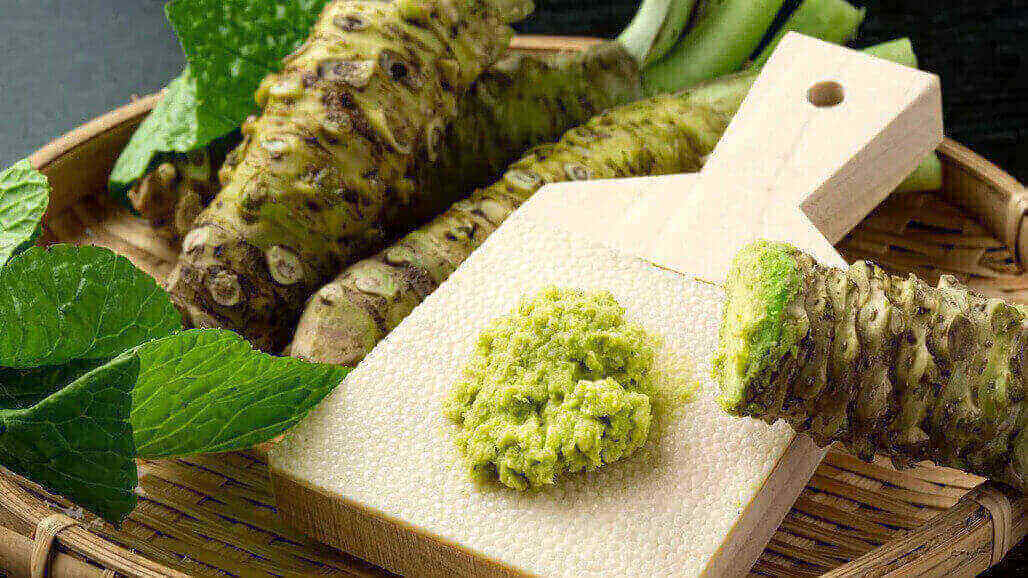
Are you curious about the intriguing world of Japanese cuisine? Have you ever wondered about the unique condiment known as wasabi? If so, then this article is perfect for you! Join us as we dive into the captivating realm of wasabi, also known as Japanese horseradish. Discover its distinctive flavor, its role in traditional dishes like sushi and sashimi, and its potential health benefits. Whether you’re a food enthusiast or simply eager to expand your culinary knowledge, this article will surely leave you craving more.
What is Wasabi?
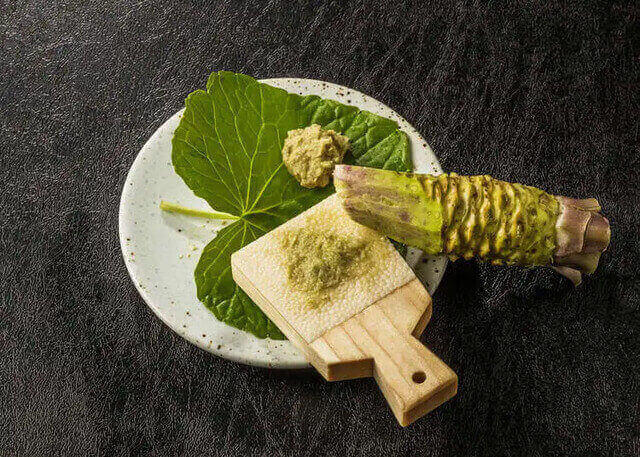

Wasabi, often referred to as Japanese horseradish, is a popular condiment in Japan known for its strong, pungent flavor. People commonly use it as a spice to accompany various dishes in Japanese cuisine. The root of the Wasabia japonica plant, native to Japan, produces true wasabi. The scientific name is Wasabia Japonica. The term “wasabia” is derived from the Japanese term wasabi, and Japonica comes from Japonicus (meaning “of Japan”). It grows in mountain streams and wetlands and blooms small white flowers with four petals in spring.
Grating the root yields a green paste that serves as a condiment. Sushi, sashimi, and other raw fish dishes typically incorporate horseradish as it helps counterbalance the rich taste of fish and adds a refreshing kick. Japanese cooking also employs horseradish in various sauces, dressings, and marinades. Additionally, horseradish is believed to possess antibacterial properties and often utilized to prevent food poisoning.
Wasabi History
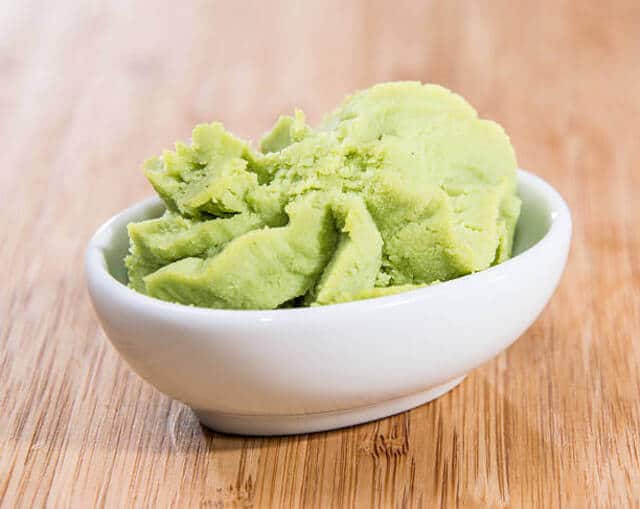

In the early Edo period, cultivation of wasabi began. During the Keicho era (1516-), villagers from Izu presented wasabi to the first shogun Tokugawa Ieyasu, who resided in Sunpu Castle then. The legend Tokugawa Ieyasu, captivated by the delicious taste and the resemblance of horseradish leaves to his family crest, kept the cultivation method a secret. In the Edo period’s Bunka Bunsei era (1804-1830), horseradish started being used as a condiment for sushi. The invention of nigiri sushi with horseradish sparked a trend among the common people in the bustling town of Edo.
During that period, with no freezers or refrigerators available, people relied on the knowledge gained from experience. They believed that horseradish could prevent food poisoning by suppressing the fishy smell of food and inhibiting bacterial growth. Thus, locals used horseradish as a precautionary measure. In the early Taisho era, when refrigeration technology and logistics were underdeveloped, powdered horseradish emerged as a result of drying and grinding the plant, taking inspiration from tea-making techniques. Subsequently, powdered wasabi using horseradish as a primary ingredient was developed, and eventually, in 1971, wasabi paste became the mainstream option.
Three major wasabi in Japan
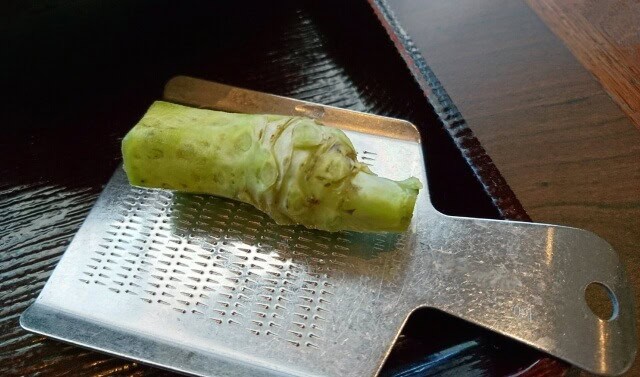

Mazuma
Mazuma is one of the most widely grown and popular varieties of wasabi, known for its strong and distinctive flavor that balances spiciness and sweetness. People highly regard Mazuma for its high-quality taste and it finds common usage in traditional Japanese cuisine.
Daruma
Daruma, another well-known variety of wasabi, stands out with its vibrant green color and intense heat. Compared to other varieties, Daruma exhibits a stronger spiciness, making it a preferred choice for those who seek a fiery kick in their dishes.
Shimane Sango
Shimane Sango also referred to as “Sango” or “Shimane Gold,” has gained popularity as a relatively newer variety of wasabi. It is cultivated in the Shimane Prefecture and catches attention with its bright yellow color and mild flavor. Shimane Sango is sought after due to its unique appearance and subtle, nuanced taste.
Foods to eat with Wasabi
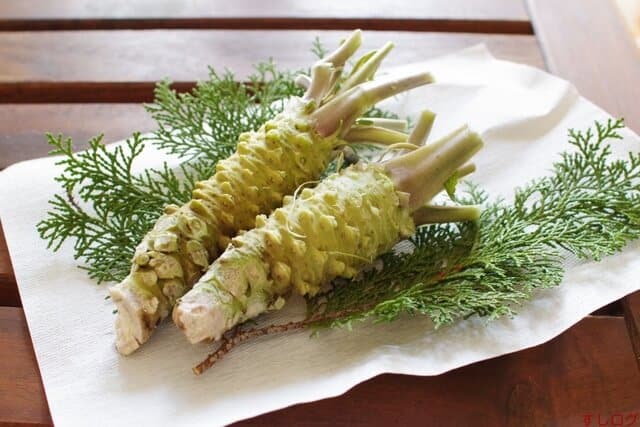

Sashimi
It adds a punch of flavor to the delicate taste of raw fish and helps to cleanse the palate between each bite. While wasabi adds spiciness, it is not the best match for oily fish like tuna. However, for white fish and squid, feel free to add more wasabi as desired to enhance the flavors.
Salmon Roe
To enjoy salmon roe, place it on warm rice or vinegared rice, and then sprinkle grated horseradish on top. The distinct richness of the salmon roe blends beautifully with the addition of wasabi.
Beef Steak
The combination of beef steak and wasabi is highly recommended. Especially with fatty cuts of meat, generously adding it enhances the experience. The pungent taste of horseradish stimulates saliva secretion and aids in digestion and food absorption.
Tamago Kake Gohan
Adding wasabi to tamago kake gohan, a dish of raw egg mixed with rice, creates an addictive taste. The richness of the raw egg pairs wonderfully with the refreshing aroma and flavor.
Health Facts of Wasabi
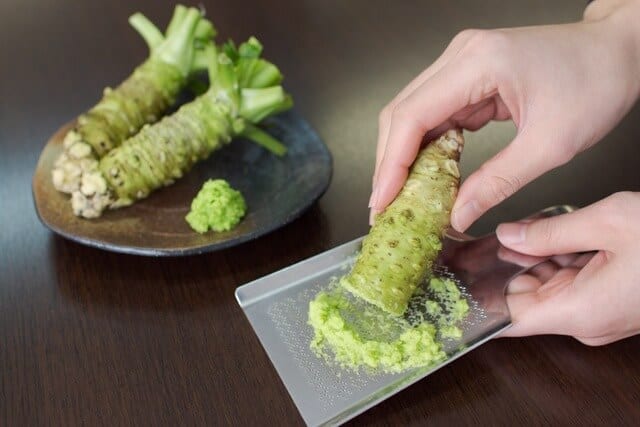

Wasabi offers not only a distinct flavor but also potential health benefits. It possesses antibacterial properties due to compounds like isothiocyanates, which can combat various bacteria and prevent food poisoning. The pungent compounds in horseradish, including allyl isothiocyanate, stimulate saliva and digestive enzymes, aiding digestion and potentially alleviating discomfort. Additionally, horseradish contains compounds with anti-inflammatory and antioxidant effects, which may help reduce inflammation, protect against oxidative stress, and support overall health. The strong aroma and pungency of horseradish can temporarily relieve nasal congestion and sinus discomfort. It’s important to consume wasabi in moderation, as its health benefits are still being studied, and excessive amounts may cause discomfort.
How to grow Wasabi?
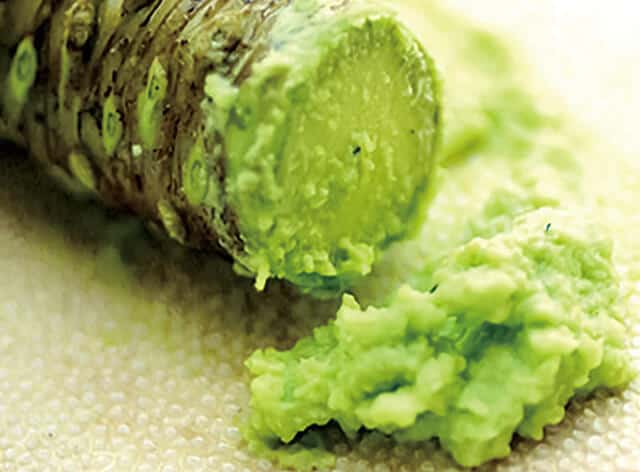

Growing horseradish requires specific conditions and care. Here are the general steps: Choose a cool, shaded location with moist, well-drained soil. Plant the rhizomes with the growing points facing up, partially covered with soil. Provide shade to protect from direct sunlight. Water regularly to maintain consistent moisture without overwatering. Apply organic fertilizers and control weeds. Harvest the rhizomes after one to two years. Growing horseradish can be challenging, so seek guidance from local experts for successful cultivation.
Wasabi FAQ
- Why do locals use wasabi for sashimi?
-
Locals use wasabi with sashimi because its pungent and spicy flavor enhances the delicate taste of raw fish, providing a refreshing kick and balancing the richness of the fish. It also has antibacterial properties which help reduce the risk of foodborne illnesses associated with consuming raw seafood. Additionally, the strong aroma and sinus-clearing properties of horseradish create a sensory experience, temporarily opening nasal passages and adding to the enjoyment of the meal.
- What is the best season of wasabi?
-
The best season for horseradish is typical during the colder months, specifically from late autumn to early spring. Horseradish plants thrive in cool, shady environments with a constant supply of fresh water, making this time of the year ideal for their cultivation. The colder temperatures enhance the flavor and spiciness of the wasabi, resulting in a more intense and enjoyable taste.
How to make Wasabi
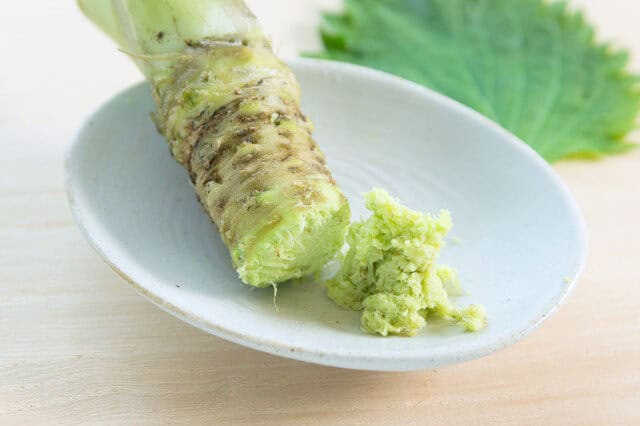

Choose firm and plump horseradish rhizomes from a reliable source. Fresh rhizomes will have a vibrant green color and a strong aroma.
Wash the rhizome gently under running water to remove any dirt or impurities. Use a brush to scrub the surface if needed.
Using a traditional Japanese grater or a fine grater, grate the horseradish rhizome into a paste. If you don’t have a grater, you can use a mortar and pestle to crush the rhizome into a paste-like consistency.
Gradually add a small amount of water to the grated horseradish to achieve the desired consistency. The water helps to release the flavors and aromas. Add water little by little and mix well until the paste becomes smooth but not too watery.
Once the wasabi paste has rested, it is ready to be served. Use it as a condiment alongside sushi, sashimi, or other dishes of your choice. Remember that fresh wasabi is potent, so use it sparingly and adjust the amount according to your taste preferences.
Where to buy Wasabi
Izuya Wasabiten (イズヤワサビテン (伊豆屋わさび店)


“Izuya Wasabiten” in Izu City is a wasabi specialty store run by Yoshio Ando and directly managed by a wasabi farm. They wash off the dirt on the horseradish, carefully prune the roots, check for damage, and sort the wasabi for real wasabi and processed products. In addition to wasabi pickles, they also sell sanbaizuke and wasabi miso. Also, this wasabi is relatively affordable at 500 to 1,000 yen per bottle. The price is because it is a directly managed store.
Wasabi Shokudo (わさび食堂)


“Wasabi Shokudo” is a wasabi specialty store run by one of the few wasabi farmers who uses such rare horseradish from Okutama, Tokyo. In this shop, they serve a bowl of wasabi rice topped with plenty of horseradish from Okutama on warm white rice. This is the perfect dish to enjoy real horseradish in luxury. Furthermore, Wasabi Shokudo uses freshly shaved bonito flakes. They have choices of wasabi don with pork and beef.
For Online Shopping
For those who want to order or buy tamagoyaki pan in Japan, you can mail it to your home via online on Rakuten. Just click here to see some shops that sell Wasabi. And for those who want to order or buy but live away from Japan. You can ship them from Rakuten. Rakuten offers International Shipping Service so do not worry about how to receive your items. Rakuten Global Express is an online shopping service that allows users to shop at stores in Japan.
Sign up
First, you need a Rakuten ID. If you are already a Rakuten member, you can start using Rakuten Global Express. If you have not registered yet, click here.
Get your personal RGX address
After signing up, you will get a Japanese address: a Rakuten Global Express address.
Shop at stores in Japan
Now that you get yourself a personal RGX address (Rakuten Global Express address). You can shop online in Japan, click here to shop for Wasabi (not only Rakuten but other online stores are also included).
When you have decided on your items, set the delivery address to your Rakuten Global Express address.
Confirm items
After items are shipped to the RGX address, they will be packed into one package. You also receive an email upon confirming these items and payment.
Once the payment is confirmed, your package will be delivered within a designated time period depending on your shipping choice.
Final Thoughts
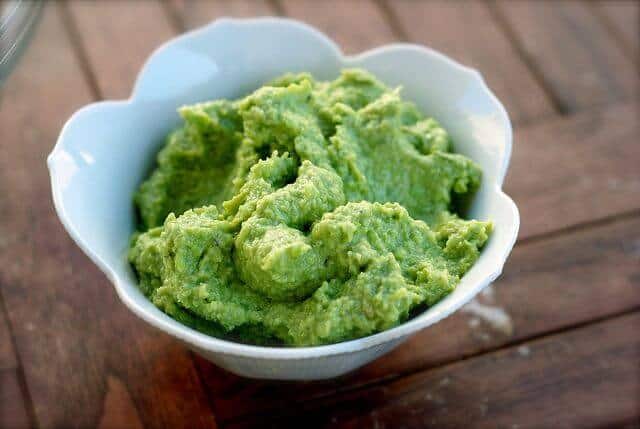

Exploring the world of wasabi reveals its unique charm and versatility. From its pungent flavor and traditional use in Japanese cuisine to its potential health benefits and fascinating cultivation process, there is much to discover and appreciate about this remarkable condiment. Whether you’re a culinary enthusiast seeking new flavors or an avid learner interested in the cultural significance of ingredients, we hope this article has provided valuable insights into the world of wasabi.
You can check some Japanese dishes below that we know you would like to try too.
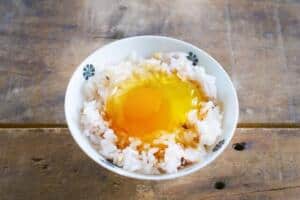

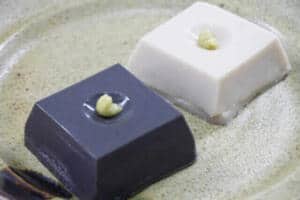

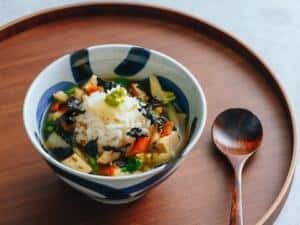



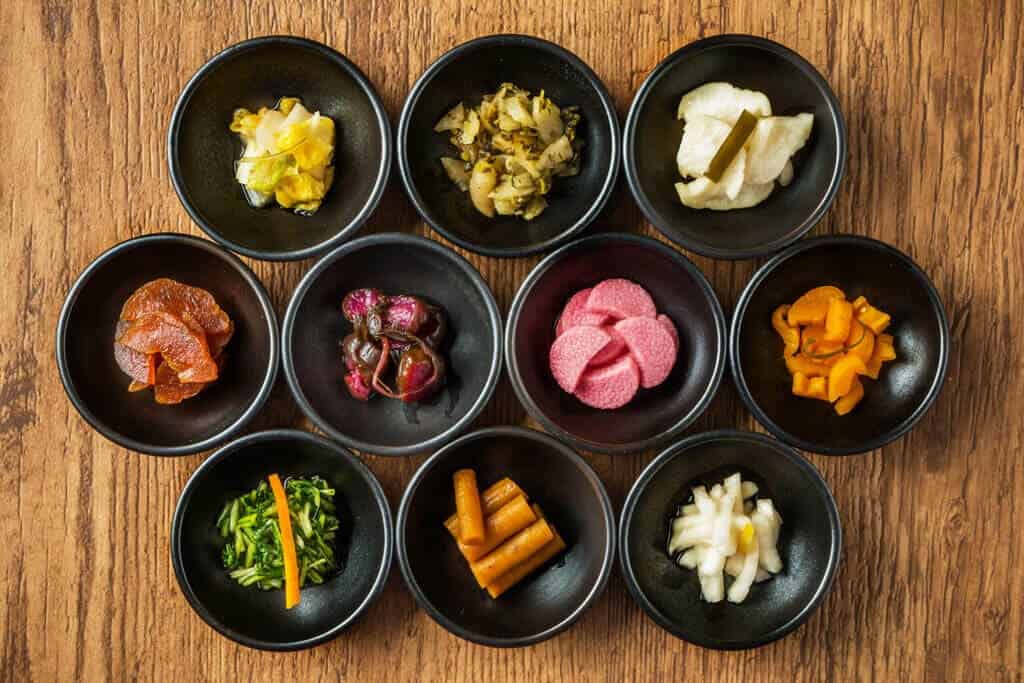
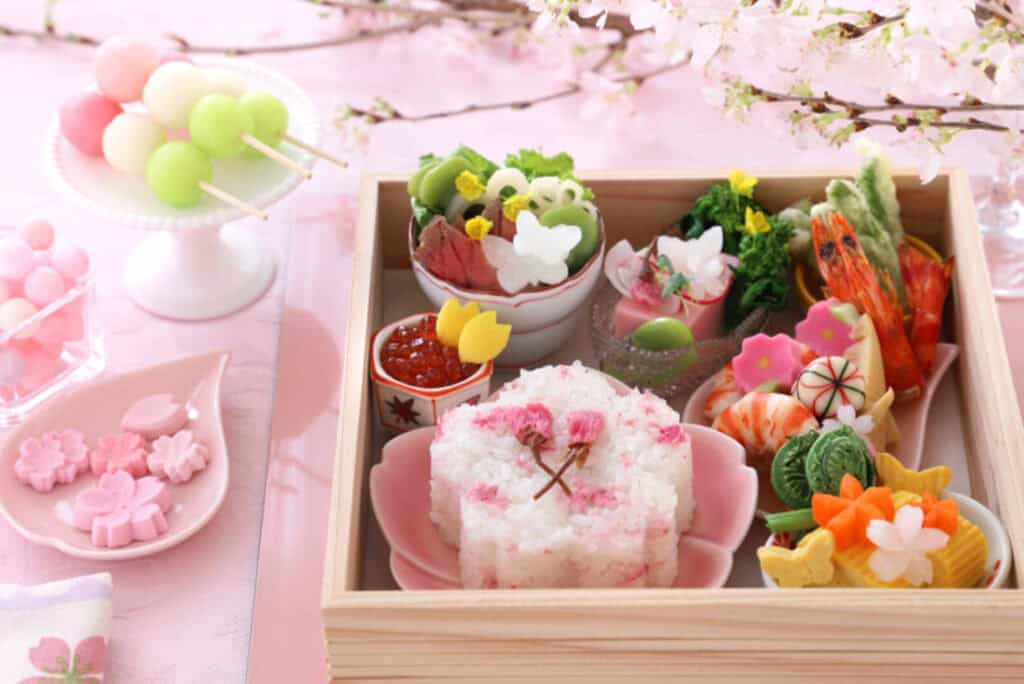


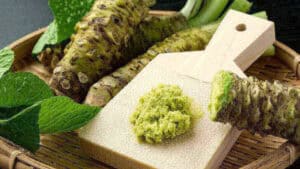
Comments